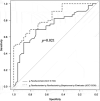Feasibility of oral microbiome profiles associated with oral squamous cell carcinoma
- PMID: 35958277
- PMCID: PMC9361761
- DOI: 10.1080/20002297.2022.2105574
Feasibility of oral microbiome profiles associated with oral squamous cell carcinoma
Abstract
Objective: Recently, the possibility that oral microbiomes is associated with oral squamous cell carcinoma (OSCC) initiation and progression has attracted attention; however, this association is still unclear. Here, we comprehensively analyze the microbiome profiles of saliva samples using next-generation sequencing followed by determining the association between oral microbiome profiles and OSCC.
Materials and methods: Microbiome profiles in saliva samples from patients with OSCC, oral leukoplakia (OLK), and postoperative OSCC (Post) were analyzed. Candidate OSCC-associated bacteria were identified by comparing the bacterial diversity and relative abundance of each group based on these microbiome profiles, and their applicability as OSCC detection tools were evaluated.
Results: There were significant differences in genus abundances (Streptococcus, Aggregatibacter, and Alloprevotella) among the groups from saliva samples. In the OSCC group, compared with the OLK and Post groups, abundances of the genus Fusobacterium, phylum Fusobacteria and phylum Bacteroidetes were markedly increased and that of the genus Streptococcus and phylum Firmicutes were decreased.
Conclusion: The results suggested a strong association of these bacteria with OSCC. Especially, phylum Fusobacterium was significantly associated with early recurrence of OSCC. Thus, oral microbiome analysis may have a potential of novel OSCC detection and prognostic tool.
Keywords: Oral squamous cell carcinoma; next-generation sequencer; oral leukoplakia; oral microbiome; saliva.
© 2022 The Author(s). Published by Informa UK Limited, trading as Taylor & Francis Group.
Conflict of interest statement
No potential conflict of interest was reported by the author(s).
Figures





Similar articles
-
Changes in oral microbial profiles associated with oral squamous cell carcinoma vs leukoplakia.J Investig Clin Dent. 2019 Nov;10(4):e12445. doi: 10.1111/jicd.12445. Epub 2019 Jul 24. J Investig Clin Dent. 2019. PMID: 31342659
-
Compositional and functional changes in the salivary microbiota related to oral leukoplakia and oral squamous cell carcinoma: a case control study.BMC Oral Health. 2023 Dec 19;23(1):1021. doi: 10.1186/s12903-023-03760-y. BMC Oral Health. 2023. PMID: 38115005 Free PMC article.
-
Comparative analysis of oral microbiome in saliva samples of oral leukoplakia, proliferative leukoplakia and oral squamous cell carcinoma.Front Oral Health. 2025 May 14;6:1600090. doi: 10.3389/froh.2025.1600090. eCollection 2025. Front Oral Health. 2025. PMID: 40438084 Free PMC article.
-
Diversity and compositional differences in the oral microbiome of oral squamous cell carcinoma patients and healthy controls: a scoping review.Front Oral Health. 2024 Jun 11;5:1366153. doi: 10.3389/froh.2024.1366153. eCollection 2024. Front Oral Health. 2024. PMID: 38919733 Free PMC article.
-
Microbial dysbiosis in oral squamous cell carcinoma: A systematic review and meta-analysis.Heliyon. 2023 Jan 24;9(2):e13198. doi: 10.1016/j.heliyon.2023.e13198. eCollection 2023 Feb. Heliyon. 2023. PMID: 36793959 Free PMC article. Review.
Cited by
-
Oral squamous cell carcinomas: state of the field and emerging directions.Int J Oral Sci. 2023 Sep 22;15(1):44. doi: 10.1038/s41368-023-00249-w. Int J Oral Sci. 2023. PMID: 37736748 Free PMC article. Review.
-
Comparative analysis of bacterial abundance and diversity in tumour tissue of oral squamous cell carcinoma and non-tumour tissue: insights from a systematic review of 16S ribosomal RNA sequencing.BMC Oral Health. 2025 Apr 16;25(1):577. doi: 10.1186/s12903-025-05941-3. BMC Oral Health. 2025. PMID: 40241078 Free PMC article.
-
Oral Microbiome-Mediated Carcinogenesis in Oral Cavity Cancer: A Narrative Review.Cureus. 2025 Apr 30;17(4):e83242. doi: 10.7759/cureus.83242. eCollection 2025 Apr. Cureus. 2025. PMID: 40453286 Free PMC article. Review.
-
Mechanisms and Potential Clinical Implications of Oral Microbiome in Oral Squamous Cell Carcinoma.Curr Oncol. 2023 Dec 28;31(1):168-182. doi: 10.3390/curroncol31010011. Curr Oncol. 2023. PMID: 38248096 Free PMC article. Review.
-
Microbiome analysis of saliva from oral squamous cell carcinoma (OSCC) patients and tobacco abusers with potential biomarkers for oral cancer screening.Heliyon. 2023 Nov 8;9(11):e21773. doi: 10.1016/j.heliyon.2023.e21773. eCollection 2023 Nov. Heliyon. 2023. PMID: 38034672 Free PMC article.
References
LinkOut - more resources
Full Text Sources
